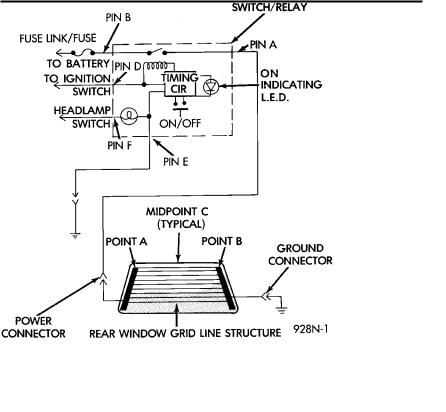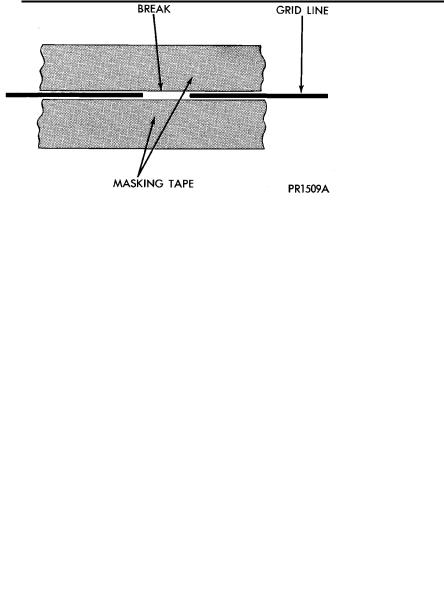
FWD / 92FWD_8N
.PDF
Ä |
|
REAR WINDOW DEFOGGER 8N - 1 |
|
REAR WINDOW DEFOGGER
CONTENTS
|
page |
CONTROL SWITCH/TIMER RELAY MODULE |
. . . 1 |
GENERAL INFORMATION . . . . . . . . . . . . . . . |
. . . 1 |
GENERAL INFORMATION
For proper operation of the Rear Window Defogger system refer to the Owner's Manual.
Vehicles equipped with an electrically heated rear window defogger also have a 40/90 amp alternator.
The system consists of a rear glass with two vertical bus bars and a series of electrically connected grid lines fired on the inside surface. A control switch and a timer relay combined into a single assembly is used on all models (Fig. 1).
Fig. 1 Rear Window Defogger Ð Typical
Circuit protection is provided by a fusible link, located in the charging circuit, for the heated grid circuit and by a fuse for the relay control circuit.
When the switch is turned to the ON position, current is directed to the rear defogger grid lines. The heated grid lines heat the rear glass to clear the surface of fog or frost.
CAUTION: Grid lines can be damaged or scraped off with sharp instruments, care should be taken in cleaning glass or removing foreign materials, decals or stickers. Normal glass cleaning solvents or hot water used with rags or toweling is recommended.
|
page |
REPAIR GRID LINES, TERMINALS |
|
AND PIGTAILS . . . . . . . . . . . . . . . . . . . . . . . |
. . 3 |
SERVICE PROCEDURES . . . . . . . . . . . . . . . . . |
. . 1 |
CONTROL SWITCH/TIMER RELAY MODULE
The control switch and timer relay are integrated into a single panel or console mounted assembly. Actuating the switch energizes the circuit which allows current to flow through the grid lines. Upon initial actuation for approximately ten minutes, or until either the switch or ignition is turned off. An indicating lamp illuminates a lens inlaid in the control switch.
SERVICE PROCEDURES
Electrically heated rear window defogger operation can be checked in vehicle in the following manner:
(1)Turn ignition ON.
(2)Turn rear window defogger control switch ON.
(3)Using a ammeter on the battery. Turn the Defogger control switch ON, a distinct increase in amperage draw should be noted.
(4)The rear window defogger operation can be checked by feeling the glass. A distinct difference in temperature between the grid lines and adjacent clear glass can be detected in three to four minutes of operation.
(5)Using a DC voltmeter (Fig. 2) contact terminal B with the negative lead, and terminal A with the positive lead. The voltmeter should read 10-14 volts.
Fig. 2 Rear Glass Grid Line Test Ð Typical

8N - 2 REAR WINDOW DEFOGGER
(6)Steps (3, 4 or 5) above will confirm system operation. Indicator light illumination means that there is power available at the output of the relay only, and does not necessarily verify system operation.
(7)If turning the switch ON produced no distinct current draw on the ammeter the problem should be isolated in the following manner:
(a)Confirm the ignition switch is ON.
(b)Ensure that the heated rear glass feed wire is connected to the terminal or pigtail and that the ground wire is in fact grounded.
(c)Ensure that the fusible link and control circuit fuse is operational and all electrical connections are secure.
(8)When the above steps have been completed and the system is still inoperative, one or more of the following is defective:
(a)Control switch/timer relay module.
(b)All rear window grid lines would have to be broken or one of the feed wires are not connected for the system to be inoperative.
(9)If turning the switch ON produces severe voltmeter deflection, the circuit should be closely checked for a shorting condition.
(10)If the system operation has been verified but indicator lamp does not light, replace the switch.
(11)For detailed wiring information, refer to group 8W, Wiring Diagrams.
GRID TEST
The horizontal grid lines and vertical bus bar lines printed and fired on inside surface of rear window glass (Fig. 2) comprise an electrical parallel circuit. The electrically conductive lines are composed of a silver-ceramic material which when fired on glass becomes bonded to the glass and is highly resistant to abrasion. It is possible, however, that a break may occur in an individual grid line resulting in no current flow through the line. To detect breaks in grid lines the following procedure is required:
(1)Turn ignition ON and turn control switch to ON. The indicator light should come on.
(2)Using a DC voltmeter with 0-15 volt range, contact terminal B with negative lead of voltmeter. With positive lead of voltmeter, contact terminal A (Fig. 2). The voltmeter should read 10-14 volts. A lower voltage reading indicates a poor ground connection.
(3)With negative lead of voltmeter, contact a good body ground point. The voltage reading should not change.
(4)Connect negative lead of voltmeter to terminal B and touch each grid line at Mid-Point with Positive lead. A reading of approximately 6 volts indicates a line is good. A reading of 0 volts indicates a break in line between Mid-Point C and terminal A. A reading of 10-14 volts indicates a break between Mid-Point C
Ä
and terminal B. Move toward break and voltage will change as soon as break is crossed (Figs. 2 and 3).
Fig. 3 Systems Electrical Circuit
CONTROL SWITCH/TIMER RELAY MODULE TEST
Control switch/timer relay module may be tested in-vehicle or bench tested. In vehicle testing is accomplished in the following manner:
(1)Remove the switch, relay assembly from the instrument panel or console, see Group 8E, Instrument Panel and leave the switch connector plugged in.
(2)Turn ignition ON.
(3)Using a DC voltmeter, with 0-15 range, check voltage at terminals B, I and L. (Figs. 3 and 4). Terminals B and I should confirm a voltage of 10 to 14 volts to ground. Terminal L should confirm voltage to ground. When terminals B and I show no voltage, trace circuit upstream of switch/relay module for problem (wiring cut, fusible link or circuit breaker inoperative, bulkhead connector not operative, etc.). If terminal L indicates voltage, place switch in Off position. If voltage at L is still indicated or indicator lamp remains on, the switch/relay module should be replaced.
(4)If the relay checks out to this point, momentarily operate switch to ON position. The indicator lamp should come on and remain on for approximately 10 minutes. Terminal L should confirm voltage. If the indicator lamp fails to light or voltage at terminal L is not confirmed the switch/relay module should be replaced.
Bench checking of the relay may be accomplished in the following manner. By following the in-vehicle

Ä
Fig. 4 Rear Window Defogger Switch, Timer, Relay,
and Wire Connector
procedure except Step 2: With a DC power supply, apply 12 volts to terminal B and I and ground terminal G.
REPAIR GRID LINES, TERMINALS AND PIGTAILS
The repair of grid lines or the terminal is possible using the Mopar Repair Package or equivalent.
(1) Mask repair area so conductive epoxy can be extended onto the line or the bus bar (Fig. 5).
Fig. 5 Grid Line Repair Ð Typical
(2)Follow instructions in repair kit for preparing damaged area.
(3)Remove package separator clamp and mix plastic conductive epoxy thoroughly. Fold in half and cut center corner to dispense epoxy.
REAR WINDOW DEFOGGER 8N - 3
(4)For grid line, mark off area to be repaired with masking tape or a template (Fig. 5).
(5)Apply conductive epoxy through slit in masking tape. Overlap both ends of the break by 19mm (3/4 inch).
(6)For a terminal or pigtail replacement, mask adjacent areas so epoxy can be extended onto line as well as bus bar. Apply a thin layer of epoxy to area where terminal was fastened and to adjacent line.
(7)Apply a thin layer of conductive epoxy on terminal and place terminal on desired location. To prevent terminal from moving while the epoxy is curing, it must be wedged or clamped.
(8)Carefully remove masking tape from grid line.
CAUTION: Do not allow the glass surface to exceed 204°C (400°F), glass may fracture.
(9)Allow epoxy to cure 24 hours at room temperature or use heat gun with a 260°-371°C (500°-700°F) range for 15 minutes. Hold gun approximately 254mm (10 inches) from repaired area.
(10)After conductive epoxy is properly cured remove wedge from terminal and check out operation of rear window defogger. Do not attach connectors until curing is complete.
WARNING: REPAIR KIT MAY CAUSE SKIN OR EYE IRRITATION.
CONTAINS EPOXY RESIN AND AMINE TYPE HARDENER, HARMFUL IF SWALLOWED. AVOID CONTACT WITH SKIN AND EYES. FOR SKIN, WASH AFFECTED AREAS WITH SOAP AND WATER. DO NOT TAKE INTERNALLY. IF TAKEN INTERNALLY, INDUCE VOMITING; CALL A PHYSICIAN IMMEDIATELY. IF IN CONTACT WITH EYES, FLUSH WITH PLENTY OF WATER. USE WITH ADEQUATE VENTILATION. DO NOT USE NEAR FIRE OR FLAME. CONTENTS CONTAIN 3 PERCENT FLAMMABLE SOLVENTS.
WARNING: KEEP OUT OF REACH OF CHILDREN.
